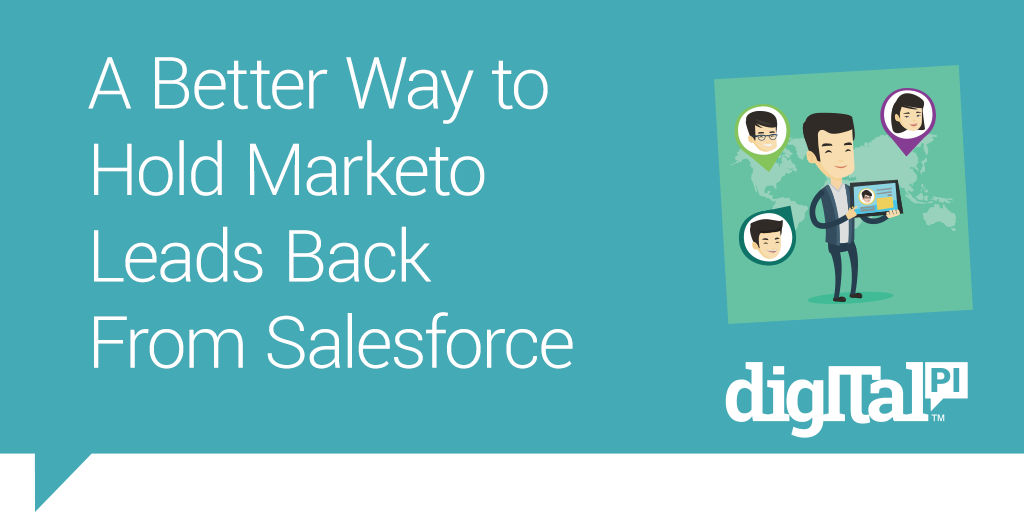
Every Marketo customer using Salesforce must define the process for when to make a lead accessible to sales. They can choose:
- Make every person (lead) available to sales all the time, beginning when the lead is created in Marketo. By this definition, when someone who is not in the database (new name) fills out a form on a company’s web site, Marketo creates a new person record in Marketo and immediately syncs the person to Salesforce.com. Then both systems carry a replica of the person – updating fields both ways whenever they are updated by either system.
- Only make a person (lead) available to sales under certain conditions. A typical example is only allowing sales to access people in Salesforce.com after they reach a certain level of engagement – for example crossing over a certain lead score threshold (e.g. MQL). By this definition, a lead that has not scored to the sales readiness threshold cannot be accessed by sales in salesforce.com. If/when the person scores over the sales readiness threshold, only then can sales see/access the lead in their SFDC lead views.
For option two – control lead visibility timing in SFDC, the question is this:
what is the best way to control when sales gets access to a lead?
One approach is to implement the controls in Marketo, disallowing leads to synch with SFDC until some condition is met (e.g. scoring threshold). The underlying rationale is this: if I don’t send the name to SFDC, then sales can’t see it. The sales ops team may like this option because it “stops marketing from cluttering up SFDC with people who aren’t ready to be pursued by sales.” But consider the real end-goal: to prevent sales from seeing/acting on leads until they are far enough along to be ready for a conversation. Yes, holding leads in Marketo will accomplish this but this approach introduces additional process considerations that require more time and effort in Marketo program setup that must be adhered to by anyone creating programs in Marketo. So, the question is, is there a better way to control when sales can access leads in SFDC? There is. First why does it matter?
In addition to synching people between SFDC and Marketo bi-directionally – it also allows you to synch Marketo Programs with SFDC Campaigns. Program-to-Campaign sync is native to Marketo. This feature makes it very simple to maintain parity of your company’s marketing between Marketo Programs and SFDC Campaigns. This can be useful for leveraging Marketo program membership in SFDC – for example, triggers, campaign views, and reporting. Here’s the catch. The instant a person enters a Marketo Program that is synched with an SFDC Campaign, Marketo creates the person in SFDC. So, if you wanted to hold that person back in Marketo – you can’t take advantage of this powerful and simple feature in Marketo. To accomplish this, instead of using Marketo’s native Program sync you must write extra logic in your Marketo programs – every program you want synched with a campaign in SFDC – to control membership sync. This method requires more work, more time, and is prone to error. Seemingly small considerations, like always having to know which SFDC Campaign name to map a Marketo program with can quickly become a real pain to manage.
The better approach is to synch all leads from Marketo to SFDC, and control lead visibility in SFDC. There are several ways to implement this. One approach uses an SFDC lead field, such as lead status, to filter lead views and reports showing only those with a sales ready status. Another approach is to use SFDC record types to control workflows and visibility.
However, the preferred method is to set up SFDC lead queues to quarantine leads from the sales team that are synched from Marketo, but not ready for sales. In this scenario, you would set up two SFDC queues:
- Marketing: this queue holds leads that have yet to exhibit any engagement. For example, this could be when lead behavior score advances beyond zero.
- Prospect: This queue is optional, depending whether your company wants to give the sales team access to leads that exhibit some engagement, but have not crossed the scoring threshold indicating the lead is sales ready (marketing qualified lead, or MQL).
This method requires that you add some simple automation (an SFDC APEX trigger) in SFDC that allows you to call lead assignment rules after the initial assignment. Standard SFDC only allows lead assignment rules to be called one time. The SFDC APEX trigger would activate when a lead in the Marketing or Prospect queue reaches MQL. You’ll need Marketo to change a value on a field recognized by the SFDC Apex trigger, so when the sync occurs the value is updated in SFDC and the trigger fires. For example, you could update Lead Status to a value that indicates MQL, or use the lead lifecycle stage carried as a custom field in SFDC. Activation of the trigger will call the SFDC lead assignment rules, reassigning the lead owner.


